How Inter-Basin Transfer of Water Alters Basin Water Stress Used for Water Footprint Characterization
Abstract
1. Introduction
2. Materials and Methods
2.1. Study Area
2.2. Description of Characterization Factors
2.3. Sources of Local Data for Computation of Local Estimates
2.3.1. Tone River Basin
2.3.2. Arakawa River Basin
2.4. The Inclusion of Inter-Basin Transfer in the Definition of the Characterization Factors
3. Results
4. Discussion
4.1. Impact of Inter-Basin Transfer on Characterization Factors
4.2. Sensibility of the Characterization Factors to Different Sources of Uncertainty
4.3. Suggestions for Assessing Soundness of the Water Cycle
- The Aqueduct framework proposed a set of indicators, which can be aggregated into a composite factor. However, because the end-user is able to decide which indicator has more or less importance in the assessment of risk, the process is subject to conflict. Thus, it was necessary to create a composite factor that can be accepted UNANIMOUSLY.
- The four selected characterization factors are able to show the degree of water stress and hence are useful for stablishing a TARGET in which consumption of water does not represent a risk.
- In this paper, we were able to REPLICATE the process of calculation of the characterization factors to validate the global estimates using local data.
- WSI includes the effect of climate variability and to some extent the effect of regulations of river flow. However, the relative measure of demand-to-availability used in its formulation may cause quite disparate results between two basins with similar levels of water consumption and similar climate variability. Therefore, the developers of fwua and CFAWARE sought to create a characterization factor that would be easy to COMPARE.
- The selected characterization factors were not able to reflect the effect of IBT in reducing the stressed state of the water cycle in the Arakawa river basin. To motivate local actions improving a sound water cycle, the assessment frameworks should allow local authorities and other stakeholders to AMELIORATE the state.
- Finally, the water footprint assessment process should be based on information that can be measured and stablishes ENGAGEMENTS of the involved stakeholders based on adequate motivations, continuity and sustainability.
- ✓
- Unanimous. A result that encourages planning based on mutual consent of stakeholders.
- ✓
- Targetable. A value that reflects sound water cycle and can be set as target.
- ✓
- Replicable. A transparent evaluation based on scientific knowledge that can be validated.
- ✓
- Ameliorable. A concise evaluation of the water cycle state encourages practical solutions.
- ✓
- Comparable. A result that can be fairly compared in spite of climatological or spatial differences.
- ✓
- Engageable. A value that reflects the level of compromise towards achieving the target.
5. Concluding Remarks
- ✓
- Due to approximations and assumptions about small-scale variability of water supply and demand, global estimates of characterization factors fail to represent the actual local conditions that might have been changed to improve the soundness of water cycles.
- ✓
- In large basins with no surface water conveyances or other changes of freshwater sources, the global estimates of characterization factors can be a good approximation of the estimates calculated with local data and observations.
- ✓
- Changes in the existing water stores and natural freshwater courses such as meltwater from glaciers, desalination in coastal regions, and IBT need to be included in the characterization of water-related risk assessments. When the change in supply is substantial, such as the Arakawa river basin receiving a volume equal to 45% of its natural supply from the Tone River, the global estimates of the selected characterization factors depicted a more “water-stressed” condition.
- ✓
- We resulted that the IBT between the Tone and Arakawa river basins decreased water risk and improve the soundness of water cycle from averaged results of characterization factors in a comprehensive manner.
- ✓
- The existing characterization factors were designed to evaluate the water-related risks for specific simplified conditions. However, appropriate risk assessments need to consider spatiotemporal variations of the availability-to-demand relation. With current ambiguity in the definition of some characterization factors, it is difficult to include local water surface conveyances such as IBT. Moreover, with a simple exercise we show how the effect of temporal variability can be ameliorated with changes of supply producing misleading results of the potential risk of climate variability.
- ✓
- Good practices towards a sound water cycle should be based on assessments that provide uTRACE results.
Author Contributions
Funding
Acknowledgements
Conflicts of Interest
References
- Sustainable Development Goals. Available online: https://www.un.org/sustainabledevelopment/ (accessed on 8 May 2018).
- Sustainable Development Goal 6. Available online: https://sustainabledevelopment.un.org/sdg6 (accessed on 8 May 2018).
- Postel, S.L.; Daily, G.C.; Ehrlich, P.R. Human appropriation of renewable fresh water. Science 1996, 271, 785–788. [Google Scholar] [CrossRef]
- Oki, T.; Kanae, S. Global hydrological cycles and world water resources. Science 2006, 313, 1068–1072. [Google Scholar] [CrossRef] [PubMed]
- WWAP (United Nations World Water Assessment Programme)/UN-Water the United Nations World Water Development Report 2018: Nature-Based Solutions for Water; UNESCO: Paris, France, 2018.
- Brutsaert, W. Hydrology: An Introduction; Cambridge University Press: Cambridge, UK, 2005. [Google Scholar]
- Responding Properly to Issues on Water Resources. Available online: http://www.mlit.go.jp/tochimizushigen/mizsei/water_resources/contents/responding_properly.html (accessed on 8 May 2018).
- Taniguchi, M. The Basic act on the water cycle with groundwater. J. Groundwater Hydrol. 2015, 57, 83–90. [Google Scholar] [CrossRef]
- Hoekstra, A.Y.; Chapagain, A.K.; Aldaya, M.M.; Mekonnen, M.M. The Water Footprint Assessment Manual: Setting the Global Standard; Earthscan: London, UK, 2011. [Google Scholar]
- Water Footprint Network Website. Available online: http://waterfootprint.org/en/ (accessed on 10 May 2018).
- ISO. ISO 14040:2006 Environmental Management-Life Cycle Assessment-Principles and Framework; International Organization for Standardization: Geneva, Switzerland, 2006. [Google Scholar]
- ISO. ISO 14046 Environmental Management, Water Footprint—Principles, Requirements and Guidelines; International Organization for Standardization: Geneva, Switzerland, 2014. [Google Scholar]
- Shiklomanov, I.A. Appraisal and assessment of world water resources. Water Int. 2000, 25, 11–32. [Google Scholar] [CrossRef]
- Oki, T.; Yano, S.; Hanasaki, N. Economic aspects of virtual water trade. Environ. Res. Lett. 2017, 12, 044002. [Google Scholar] [CrossRef]
- World Resources Institute AQUEDUCT Water Risk Framework; WRI: Washington, DC, USA, 2013.
- The Water Risk Filter. Available online: http://waterriskfilter.panda.org/ (accessed on 11 May 2018).
- Global Water Tool. Available online: https://www.wbcsd.org/Clusters/Water/Resources/Global-Water-Tool (accessed on 11 May 2018).
- Water Risk Monetizer. Available online: https://www.waterriskmonetizer.com (accessed on 11 May 2018).
- Pfister, S.; Koehler, A.; Hellweg, S. Assessing the environmental impacts of freshwater consumption in LCA. Environ. Sci. Technol. 2009, 43, 4098–4104. [Google Scholar] [CrossRef] [PubMed]
- Yano, S.; Hanasaki, N.; Itsubo, N.; Oki, T. Water scarcity footprints by considering the differences in water sources. Sustainability 2015, 7, 9753–9772. [Google Scholar] [CrossRef]
- Boulay, A.; Bare, J.; Benini, L.; Berger, M.; Lathuillière, M.J.; Manzardo, A.; Margni, M.; Motoshita, M.; Núñez, M.; Pastor, A.V.; et al. The WULCA consensus characterization model for water scarcity footprints: Assessing impacts of water consumption based on available water remaining (AWARE). Int. J. Life Cycle Assess. 2018, 23, 368–378. [Google Scholar] [CrossRef]
- Gassert, F.; Shiao, T.; Luck, M. Colorado River Basin Study; Working Paper; World Resources Institute: Washington, DC, USA, 2013. [Google Scholar]
- Gassert, F.; Luo, T.; Shiao, T.; Luck, M. Yellow River Basin Study; Working Paper; World Resources Institute: Washington, DC, USA, 2013. [Google Scholar]
- Gassert, F.; Luo, T.; Shiao, T.; Luck, M. Yangtze River Basin Study; Working Paper; World Resources Institute: Washington, DC, USA, 2013. [Google Scholar]
- Gassert, F.; Rai, P.; Reig, P.; Luck, M. Mekong River Basin Study; Working Paper; World Resources Institute: Washington, DC, USA, 2012. [Google Scholar]
- Reig, P.; Gassert, F.; Luck, M. Orange-Senqu River Basin Study; Working Paper; World Resources Institute: Washington, DC, USA, 2013. [Google Scholar]
- Luo, T.; Krishnan, D.; Sen, S. Parched Power, Water Demands, Risks, and Opportunities for India’s Power Sector; Working Paper; World Resources Institute: Washington, DC, USA, 2018. [Google Scholar]
- Long-Term Plans for Water Resources. Available online: http://www.mlit.go.jp/tochimizushigen/mizsei/water_resources/contents/long-term_plans.html (accessed on 17 May 2018).
- Musashi Suiro. Available online: https://www.water.go.jp/kanto/musasi/summary/index2.html (accessed on 3 September 2018).
- AQUEDUCT Measuring and Mapping Water Risk. Available online: http://www.wri.org/our-work/project/aqueduct (accessed on 11 May 2018).
- Brown, A.; Matlock, M.D. A Review of Water Scarcity Indices and Methodologies; White Paper #106; The Sustainability Consortium: Arkansas, AR, USA, 2011. [Google Scholar]
- ISO Environmental Management—Water Footprint—Illustrative Examples on How to Apply ISO 14046; International Organization for Standardization: Geneva, Switzerland, 2017.
- Rosenbaum, R.K.; Hauschild, M.Z.; Boulay, A.M.; Fantke, P.; Laurent, A.; Núñez, M.; Vieira, M. Life cycle impact assessment. In Life Cycle Assessment: Theory and Practice; Hauschild, M., Rosenbaum, R., Olsen, S., Eds.; Springer: Cham, Switzerland, 2018. [Google Scholar]
- Nilsson, C.; Reidy, C.A.; Dynesius, M.; Revenga, C. Fragmentation and flow regulation of the world’s large river systems. Science 2005, 308, 405–408. [Google Scholar] [CrossRef] [PubMed]
- Yano, S.; Hanasaki, N.; Itsubo, N.; Oki, T. Potential impacts of food production on freshwater availability considering water sources. Water 2016, 8, 163. [Google Scholar] [CrossRef]
- Database of Dams. Available online: http://mudam.nilim.go.jp/home (accessed on 7 June 2018).
- Basin Development Plan of Tone River System. Available online: http://www.ktr.mlit.go.jp/river/shihon/index00000038.html (accessed on 7 June 2018).
- AMeDAS. Available online: https://www.jma.go.jp/jma/en/Activities/amedas/amedas.html (accessed on 31 July 2018).
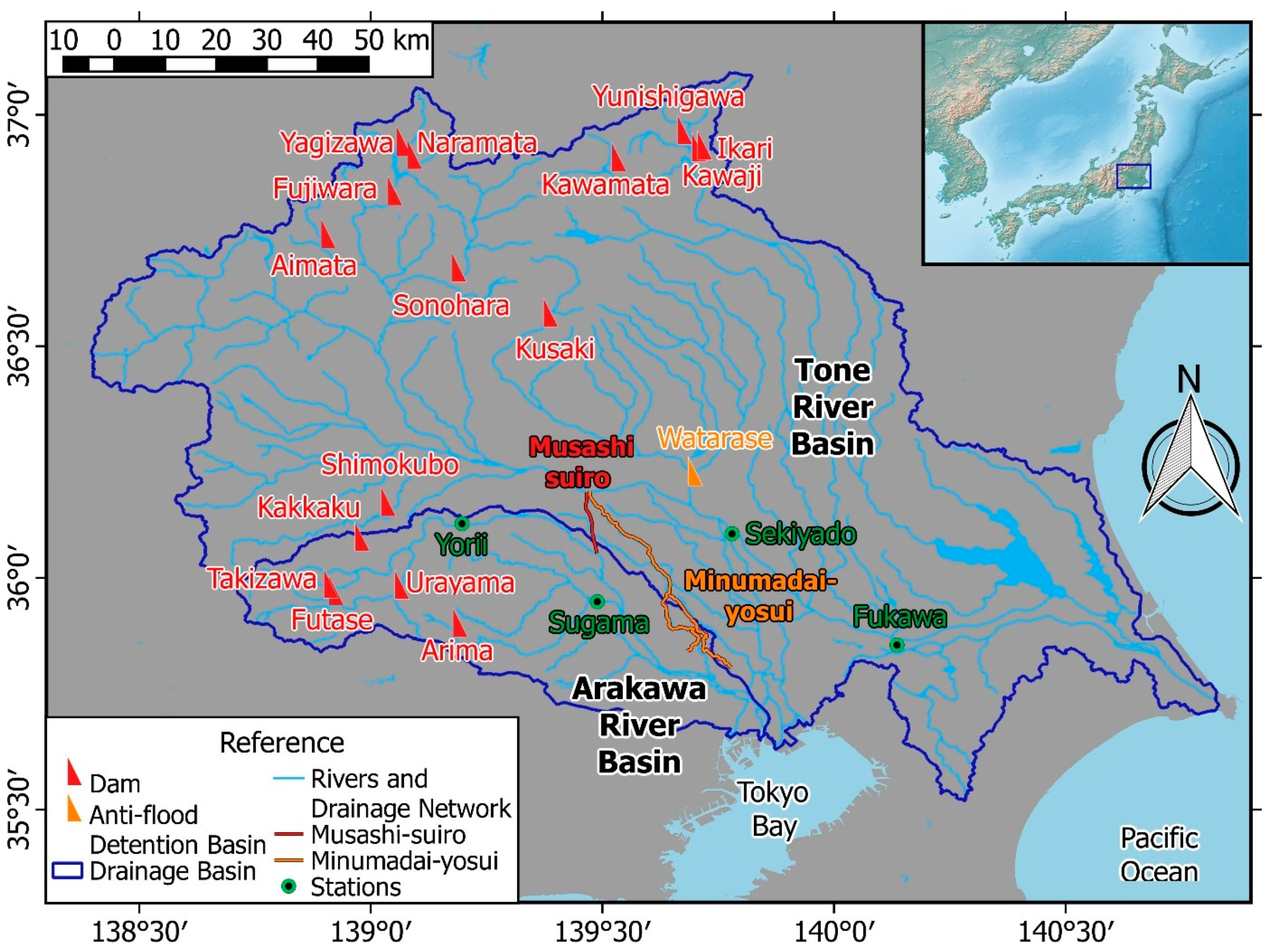
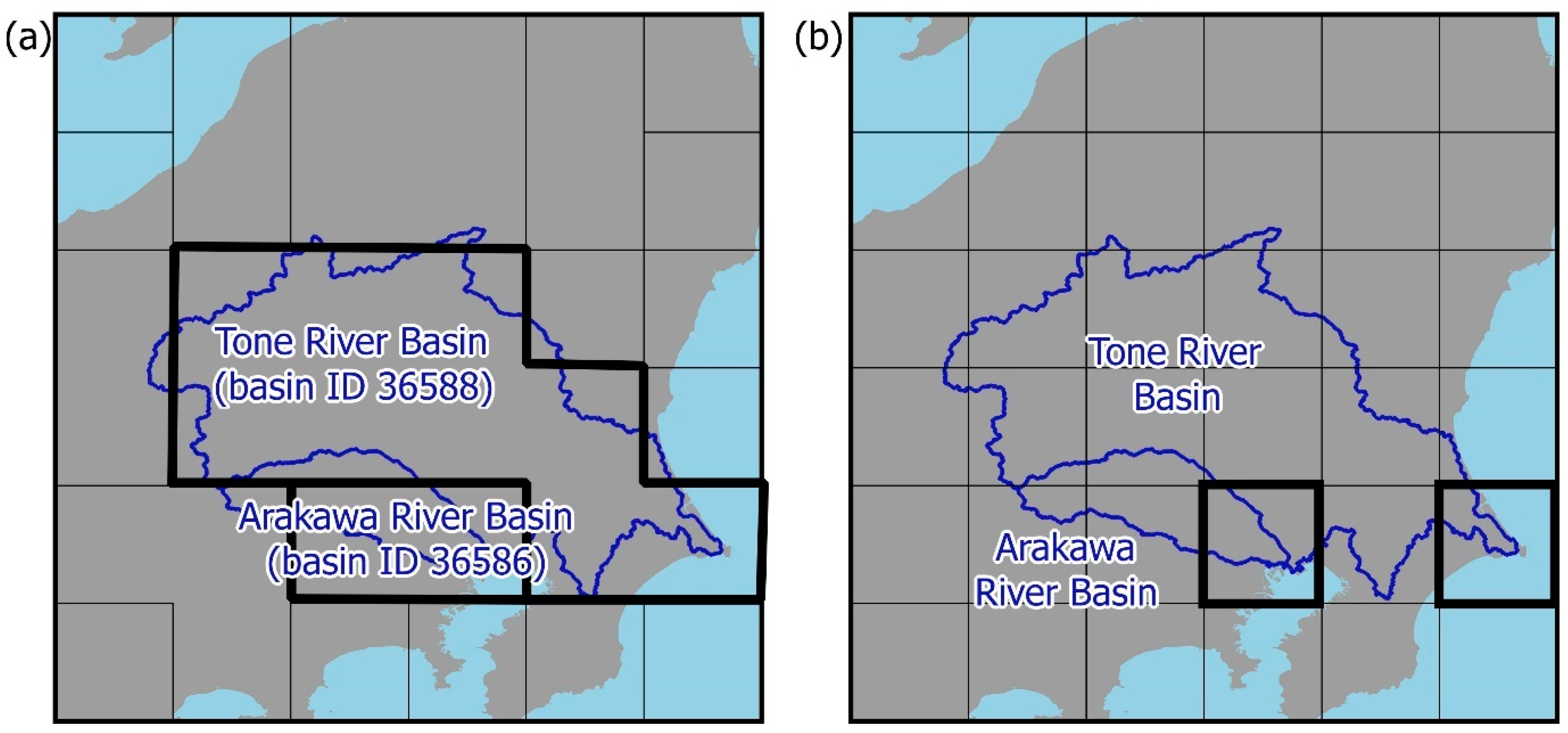
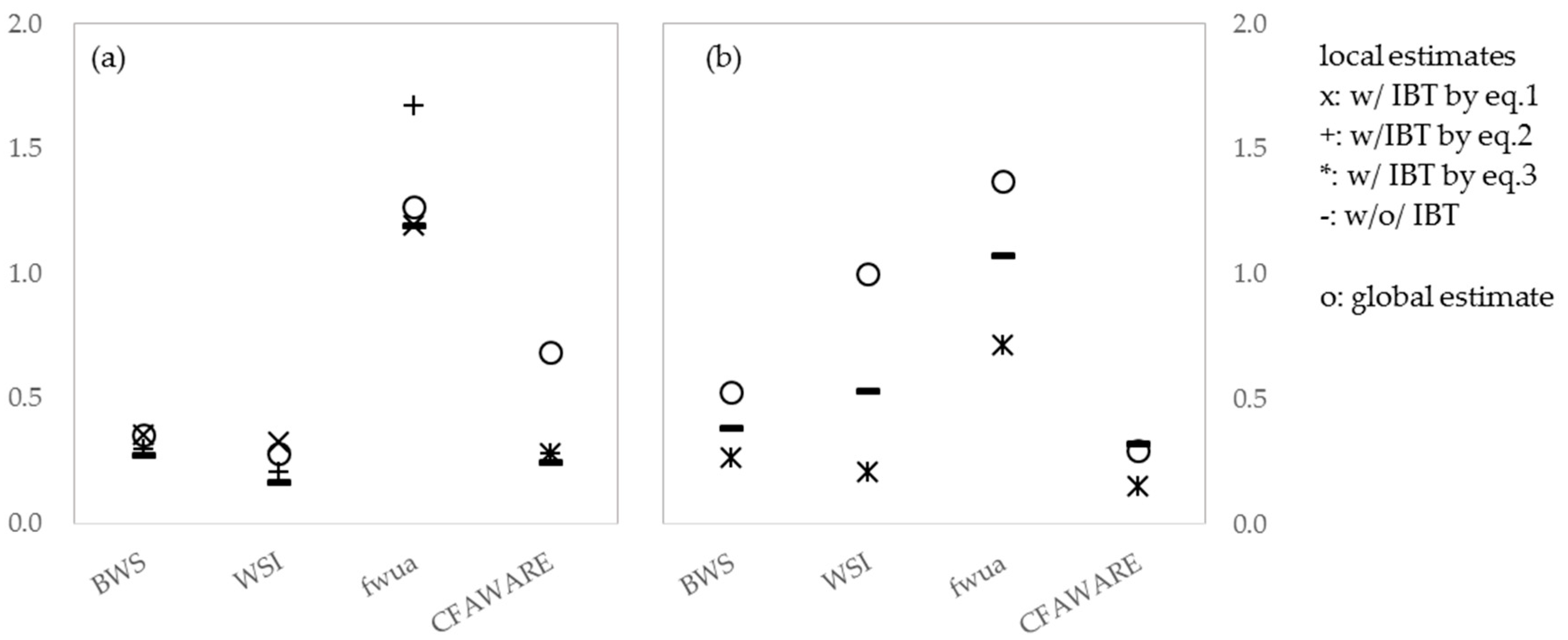
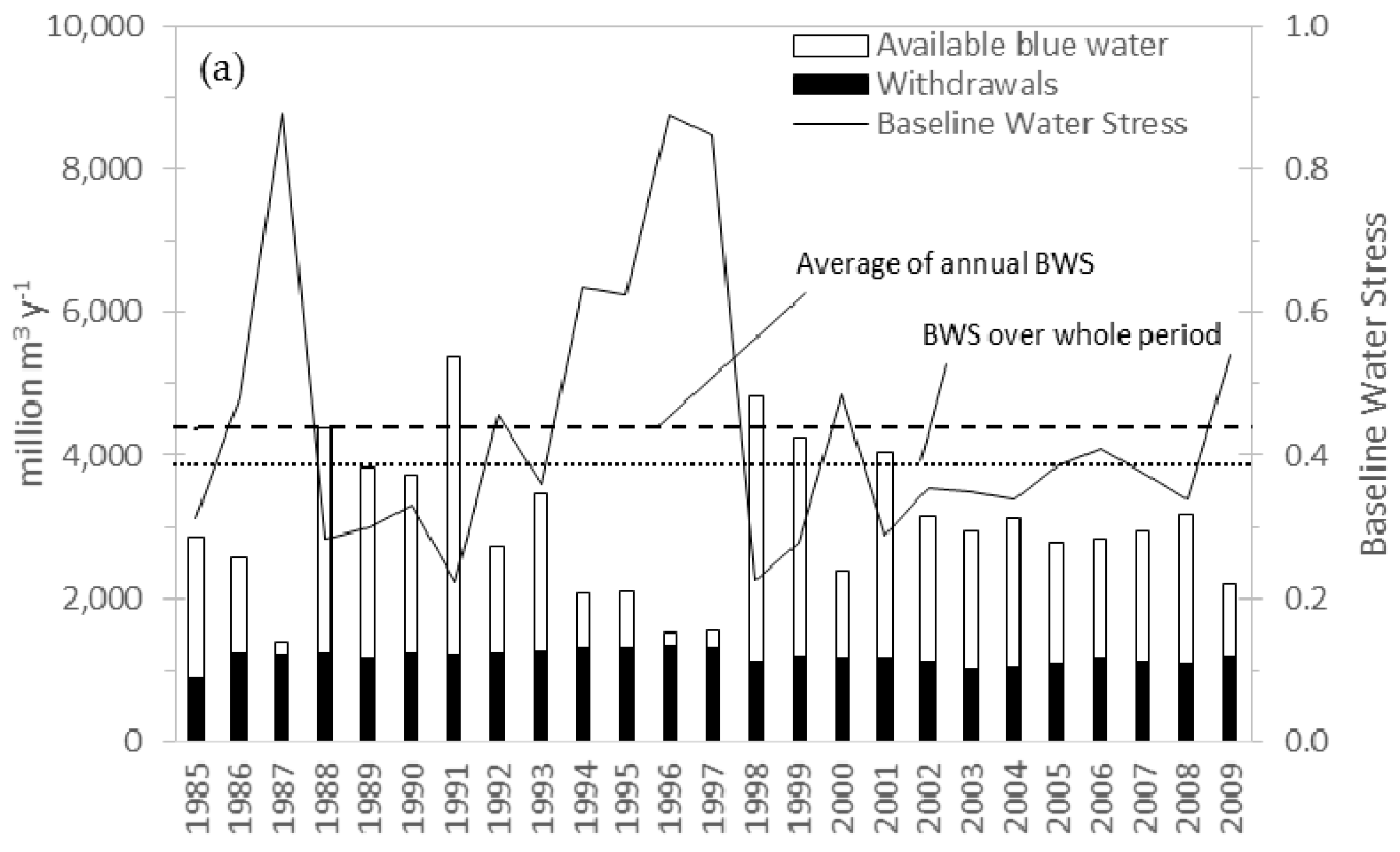
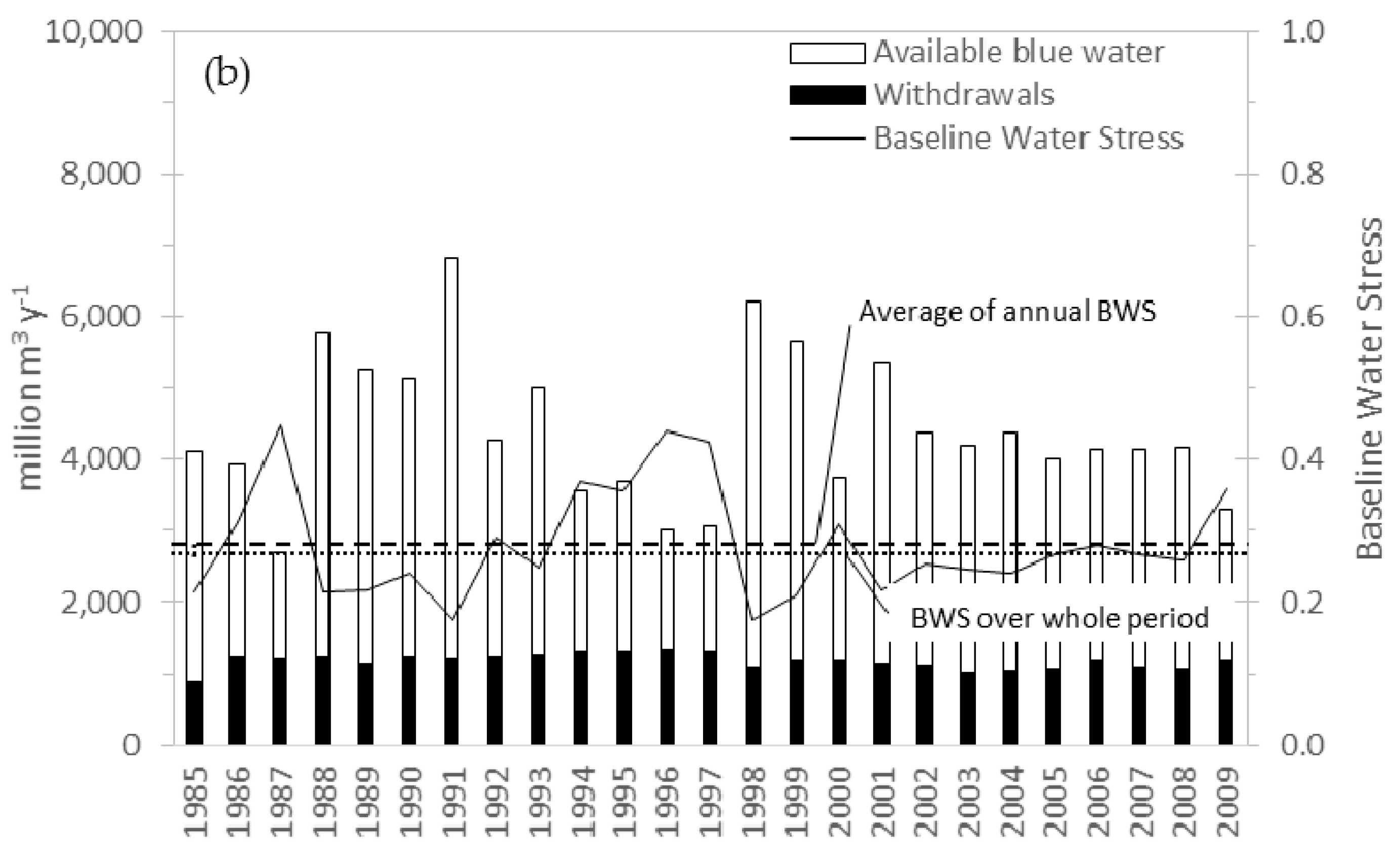
| Indicator | Expression | Range | Resolution |
|---|---|---|---|
| Baseline Water Stress (BWS) [15] | 0~∞ | Basin | |
| Water Stress Index (WSI) [19] | WTA*: adjusted WTA (WTA: withdrawal to availability) | 0.01~1 | Basin, 0.5° × 0.5° |
| Water unavailability factor (fwua) [20] | A: required land area to obtain the reference volume of water | 0~∞ (99 percentile) | 0.5° × 0.5° |
| CFAWARE [21] | AMD: availability-minus-demand | 0.1~100 | Basin, 0.5° × 0.5° |
| Variable | With IBT (Equation (1)) | SD (StanDard DeviatIons) | With IBT (Equation (2)) | SD | Without IBT | SD |
|---|---|---|---|---|---|---|
| Annual Precipitation, Pa (mm y−1) | 1458 | 178 | 1458 | 178 | 1458 | 178 |
| Annual Withdrawals, Ws(Mm3 y−1) | 5824 | 278.9 | 4509 | 238.7 | 4509 | 238.7 |
| Available Blue Water, Qs (Mm3 y−1) | 16,397 | 3195.4 | 15,082 | 3220.8 | 16,397 | 3195.4 |
| Transferred Water, T (Mm3 y−1) | 1315 | 1315 | 0 | |||
| Human Water Consumption (Mm3 y−1) | 2695 | 2695 | 1384 | |||
| Environmental Water Requirements (Mm3 y−1) | 946 | 946 | 946 |
| Variable | With IBT (Equation (3)) | SD | Without IBT | SD |
|---|---|---|---|---|
| Annual Precipitation, Pa (mm y−1) | 1447 | 229 | 1447 | 229 |
| Annual Withdrawals, Ws (Mm3 y−1) | 1181 | 85.2 | 1181 | 85.2 |
| Available Blue Water, Qs (Mm3 y−1) | 4412 | 1024.7 | 3052 | 1020.9 |
| Transferred Water, T (Mm3 y−1) | 1360 | 0 | ||
| Human Water Consumption (Mm3 y−1) | 79 | 79 | ||
| Environmental Water Requirements (Mm3 y−1) | 158 | 158 |
© 2018 by the authors. Licensee MDPI, Basel, Switzerland. This article is an open access article distributed under the terms and conditions of the Creative Commons Attribution (CC BY) license (http://creativecommons.org/licenses/by/4.0/).
Share and Cite
Yano, S.; Okazumi, T.; Iwasaki, Y.; Yamaguchi, M.; Nakamura, K.; Kanayama, T.; Ogawada, D.; Matsumura, A.; Gomez-Garcia, M.; Oki, T. How Inter-Basin Transfer of Water Alters Basin Water Stress Used for Water Footprint Characterization. Environments 2018, 5, 105. https://doi.org/10.3390/environments5090105
Yano S, Okazumi T, Iwasaki Y, Yamaguchi M, Nakamura K, Kanayama T, Ogawada D, Matsumura A, Gomez-Garcia M, Oki T. How Inter-Basin Transfer of Water Alters Basin Water Stress Used for Water Footprint Characterization. Environments. 2018; 5(9):105. https://doi.org/10.3390/environments5090105
Chicago/Turabian StyleYano, Shinjiro, Toshio Okazumi, Yoshihisa Iwasaki, Masahiro Yamaguchi, Kenichi Nakamura, Takuhiro Kanayama, Daikichi Ogawada, Akiko Matsumura, Martin Gomez-Garcia, and Taikan Oki. 2018. "How Inter-Basin Transfer of Water Alters Basin Water Stress Used for Water Footprint Characterization" Environments 5, no. 9: 105. https://doi.org/10.3390/environments5090105
APA StyleYano, S., Okazumi, T., Iwasaki, Y., Yamaguchi, M., Nakamura, K., Kanayama, T., Ogawada, D., Matsumura, A., Gomez-Garcia, M., & Oki, T. (2018). How Inter-Basin Transfer of Water Alters Basin Water Stress Used for Water Footprint Characterization. Environments, 5(9), 105. https://doi.org/10.3390/environments5090105




